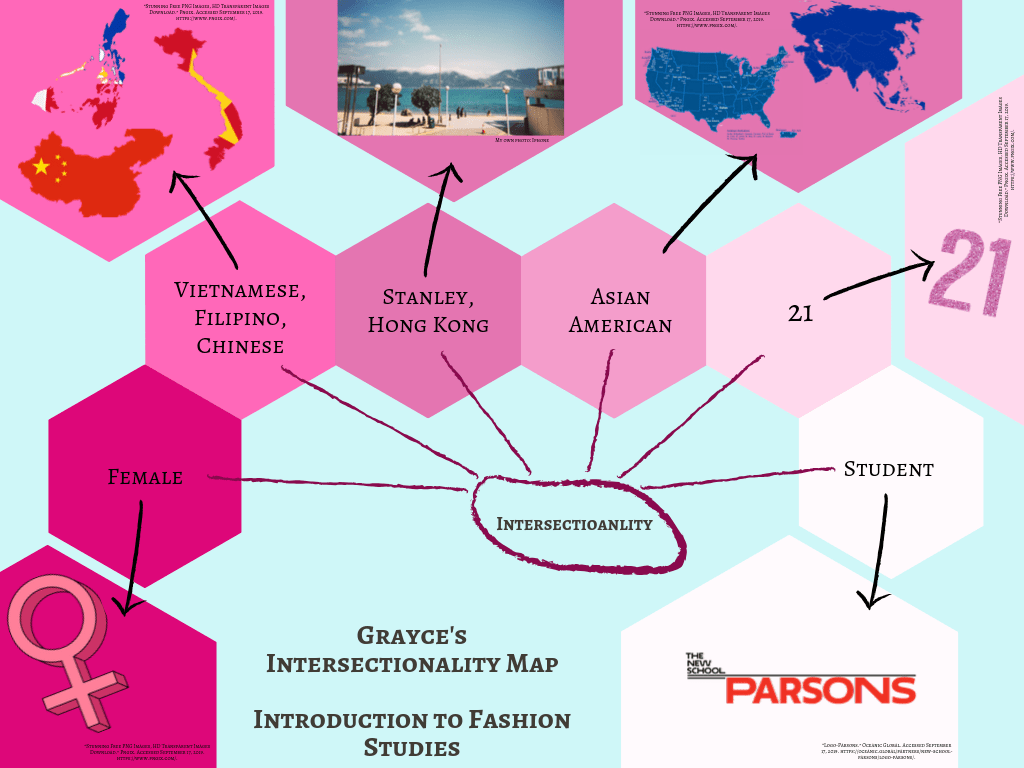My intersectionality map includes 6 subject positions. Starting from left to right. I am female. I am ethnically Vietnamese, Filipino, and Chinese. My home town is Stanley, Hong Kong. My nationality is Asian-American. I am 21 years old. I am a student at Parsons School of Design.
When reflecting on intersectionality, I think of puzzle pieces that consist of my physical, genetic, personality traits, and feelings that connect as one to form a whole puzzle. Intersectionality is the combination and composition of traits of one single person. Within the lecture slideshow intersectionality is defined as “What we call our “identities” are made up of multiple, interconnected subject positions.” My intersectionality map highlights 6 traits that define who I am. Although they are in separate categories, they all connect with each other through the process of intersectionality. Within Chapter 2 of Fashion and Cultural Studies written by Susan B. Kaiser, explains Kimberly Crenshaw’s description of all the categories of intersectionality. It states, “None of the subject positions in Figure 2.2 are distinct from one another; instead, they intersect with each other and indeed with other subject positions that cannot be covered in greater depth due to space limitations.” To me this means that these 6 subject positions generally describe who I am however, there are an infinite amount of other subject positions that can be added.
When relating my subject positions of my intersectionality map to fashion, I immediately think of Assumption 1 within Chapter 2. The first assumption was “Inevitably, people appear”. In short this assumption was explaining how people can’t evolve their appearance (fashion) without thinking and comparing themselves to other people. Humans are creatures that need interaction with each other. We constantly compare and see others appearances and make alterations to their own appearance based on their opinions of others. For example, I grew up in New York however live in Hong Kong. Growing up I was exposed to American fashion, dressed in an “American” style for the younger part of my childhood. When I moved to Asia, I was exposed to Hong Kong fashion and Asian clothing, and naturally my personal style changed to a more Asian aesthetic pulling away from American aesthetics. People like to dress similar to what culture or what they’re typically exposed to. This is because people feel comfort when they fit in with the rest of society. Those who like to dress “different” from the social norm are also affected by others through motivation of others appearances to dress boldly. Students at Parsons’s fashion is constantly feeding off each other by what we see our peers wear. Within the text it simply states, “…individuals do not accomplish this exploration completely by themselves- because they think about others as they get dressed, and because they rely on feedback from others- style-fashion-dress is a social process.” I agree with this assumption because I feel fashion is constantly taking inspiration from history and current trends. It is constantly evolving new styles and trends purely based on human interaction and what others visually see people wearing.
Overall when connecting my intersectionality web to fashion the idea of evolution comes up. I as a person am constantly evolving and experiencing life which can change factors in my subject positions. Fashion is constantly evolving and will never be in one single state or definition.
Citations:
Kaiser, Susan B. Fashion and Cultural Studies. London: Bloomsbury Visual Arts, 2018.
Map Citations:
“Logo-Parsons.” Oceanic Global. Accessed September 17, 2019. https://oceanic.global/partners/new-school-parsons/logo-parsons/.
“PngKID.com.” PngKID. Accessed September 17, 2019. http://pngkid.com/.
“Stunning Free PNG Images, HD Transparent Images Download.” Pngix. Accessed September 17, 2019. https://www.pngix.com/.
